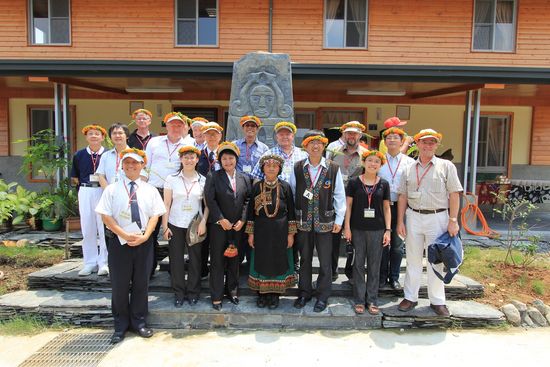


International scholars visit Morakot reconstruction sites in Taiwan

As the two-year anniversary of the August 8, 2009 Typhoon Morakot draws near, 12 experts and scholars from nine countries—including representatives from the Asia-Pacific Economic Cooperation forum, the European Union and the U.S. Agency for International Aid—today visited post-Morakot reconstruction sites for a first-hand look at the progress made and the innovative methods used in rebuilding communities ravaged by the typhoon.
The visit comes ahead of the International Conference on Post-Morakot Homeland Reconstruction and Sustainable Development, scheduled for tomorrow (July 30) at the National Sun Yat-sen University in Kaohsiung. Participants will share experiences in disaster recovery and reconstruction during the one-day conference, organized by the Morakot Post-Disaster Reconstruction Council of the Executive Yuan and the Kaohsiung-Pingtung Collegiate Alliance for the Reconstruction of the Morakot Typhoon-Affected Area.
The visit through Rinari Community, Da Ai Community, Yonglin Organic Farm, and the first phase of the Wulipu permanent housing base was led by the Reconstruction Council’s Deputy CEO Chern Jenn-chuan. At Rinari, the visitors received a warm reception from community residents as well as representatives of World Vision Taiwan and other charity groups that helped build the community. The group also paid a visit to Majia Chieftain Hsu Chun-mei, Haocha Village Chief Chen Bao-hua and Dashe Chieftain Lai Mei-xiang, paying high compliments to the tribes for their combined efforts toward the reconstruction work. The visitors took a group photo in front of the home of one of the chieftains.
In the afternoon, the group visited the Da Ai Community where the Buddhist Compassion Relief Tzu Chi Foundation shared their experiences on the foundation’s work in mobilizing rescue and relief workers, setting up a disaster relief center, building permanent houses and other operations at the community.
After the devastation caused by Morakot, Taiwan received generous aid and reconstruction assistance from the U.S., the EU, Australia, New Zealand, Japan, Thailand, Indonesia, Singapore and many other countries, said Chern, adding that such compassion is quite admirable. During the tour, the visitors saw the fruits of Taiwan’s reconstruction efforts and were able to learn from the experience, which may prove helpful for countries currently engaged in post-disaster reconstruction work, including Japan, Australia and New Zealand, he added.
Chern stressed that during the reconstruction process, Taiwan drafted a blueprint to construct permanent houses and build “colorful sustainable communities”— a two-pronged plan for restoring both “hardware” and “software” for the typhoon survivors. The plan will benefit over 10,000 people to be accommodated in 3,000 permanent houses, he added.
With nearly 90 percent of the permanent housing construction projects completed in two years’ time, the visitors were impressed with the government’s efficiency. They also expressed affirmation for the “colorful sustainability community” concept, which looks beyond housing and takes into account practical living needs such as employment, schooling, cultural and spiritual support, and community rebuilding. This concept aims to provide residents with a safe and familiar environment where they can live and work peacefully, as evidenced by the unique aboriginal designs and motifs that decorate the exteriors of the new homes. Taiwan’s model in which the government provides land and public facilities while private organizations volunteer to build the homes can serve as a good example for the international community, the visitors said.
In all, the group visited the Da-ai and Rinari communities, Shanlin organic farm, the first phase of the Wulipu permanent housing base, and the Xiaolin Village Memorial Park. The scholars and experts left with a positive impression of the successful collaboration between Taiwan’s public and private sectors to rebuild affected communities.

Rinari Residents’ welcome dance

Head of Rinari Indigenous People in tribe’s dress leads a tour for Foreign Guests

Group Photo in Head of Rinari Indigenous People Hsu Chun Mei’s house





